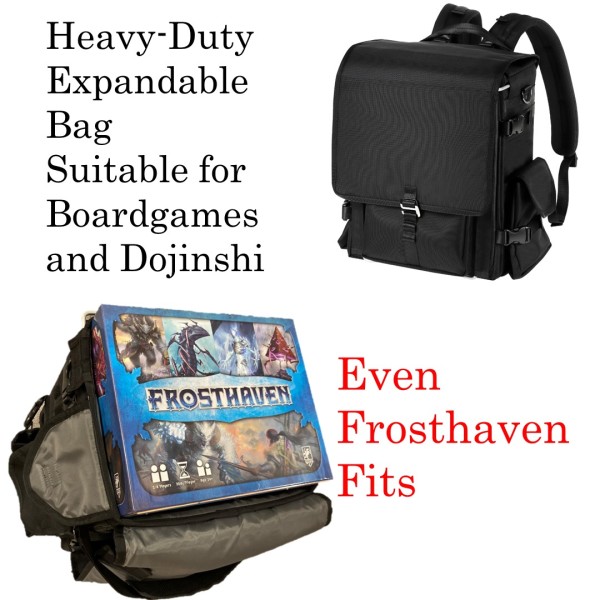
Even the Gloomhaven / Frosthaven fits.
Also It can be used for business and everyday life.
What is this Boardgame Bag named “Raven YATA”
A sturdy backpack for everyday business use, crafted to carry large amounts of documents and books. Because of its large capacity, it’s also very suited for travels, or, as we present in this Indiegogo, to carry board games to your gaming nights, or for your shopping sprees on game fairs.
All this while still being of a compact size that won’t knock away whoever’s behind you.
And the name of the bag “RAVEN YATA (八咫鴉)” is derived from a fictional raven in Japanese mythology.
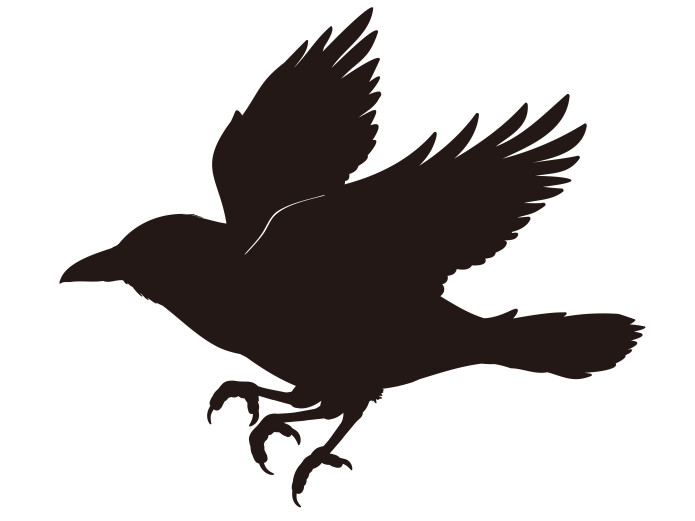
It has three legs and “YATA (八咫)” means very large.
The bag can be expanded and made larger and also uses three distinctivemetal parts.
So the name was borrowed from the mythological ”Raven Yata (八咫鴉)” (black, large, three distinctive parts), which originated in Japan.
Before we dig into the details, let’s look at how much it fits. The inside size of the bag is roughly as follows:
In unexpanded state: 7″ x 12,5″ x 16″ or 16cm x 32cm x 40cm
It expanded state: 10″ x 12,5″ x 16″ or 24cm x 32cm x 40cm
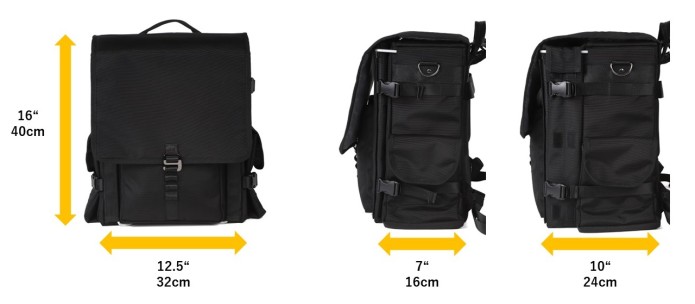
Tested with a few typical board game box sizes:
* Typical “two card decks” Coloretto sized box: even in unexpanded state, about 45 of these.
* Typical “indie size” box (6,5″ x 9″ or 16cm x 22cm): unexpanded, easily 11 with room to spare, expanded about 18 (stacked sideways). *this size is not common for the commercial market, but very common among indie productions
* “Rectangle” box (9″ x 12″ or 22cm x 30 cm): in expanded state, about 7, as you can lay them flat down. Unexpanded, you have to stack them sideways, so only about 4.
* Typical “Ticket to Ride” sized box: Easily 3 goes in in expanded state; even unexpanded you can slip in two of these, while still leaving a lot of room for fillers on the top.
* Large stuff like Nemesis: Unexpanded, base box still goes in easily. Expanded, you can fit an expansion, or even two if you’re lucky, and still leave room for fillers on top.
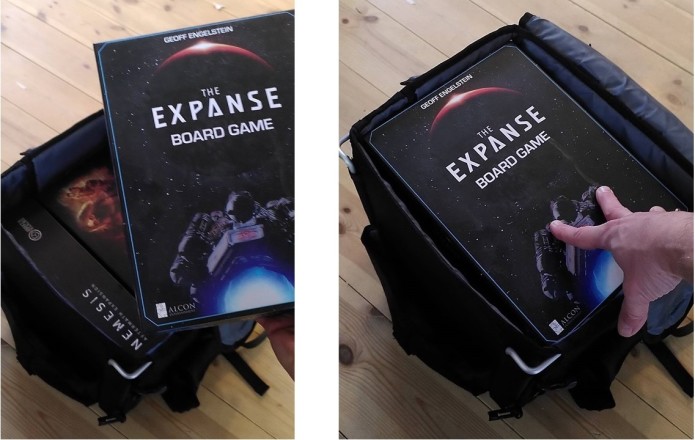
With the side pockets, you can easily cram in another handful of smaller fillers. But as you can see below; in its expanded state, Gloomhaven, and even the slightly larger Frosthaven, fits like a hand in a glove, without so much as a scratch!

But here are the details:
TYPICAL USE CASES
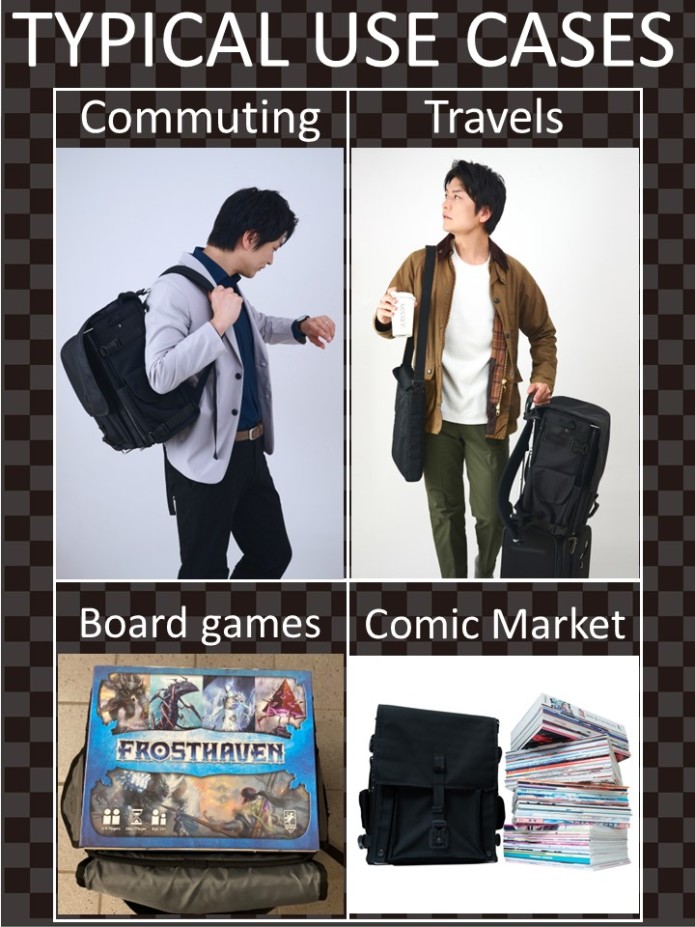
As a business backpack, it’s designed to be of a size that’s reasonable for general communting to work or school, all the while actually being able to fit huge board games like Frosthaven.
Those of you who don’t know what “Comic Market” is might, however, raise an eyebrow at that last pane.
Honesty is a virtue: This backpack was originally designed to carry, not specifically board games, but the products of another geeky hobby: Dojinshis (Fanzine) from the world’s by far largest fair for self-published comic books, “Comics Market”, a biannual fair in Japan, attracting more than 200,000 visitors per day during their three days. As Dojinshis (Fanzines) from Comics Market can usually only be bought on that specific fair, you need to buy when you can, and carry-cases is a common problem. This backpack was designed for this purpose, all the while keeping a slim size that still works in a crowded marketplace and that also can snugly be used as an every-day commuter backpack.
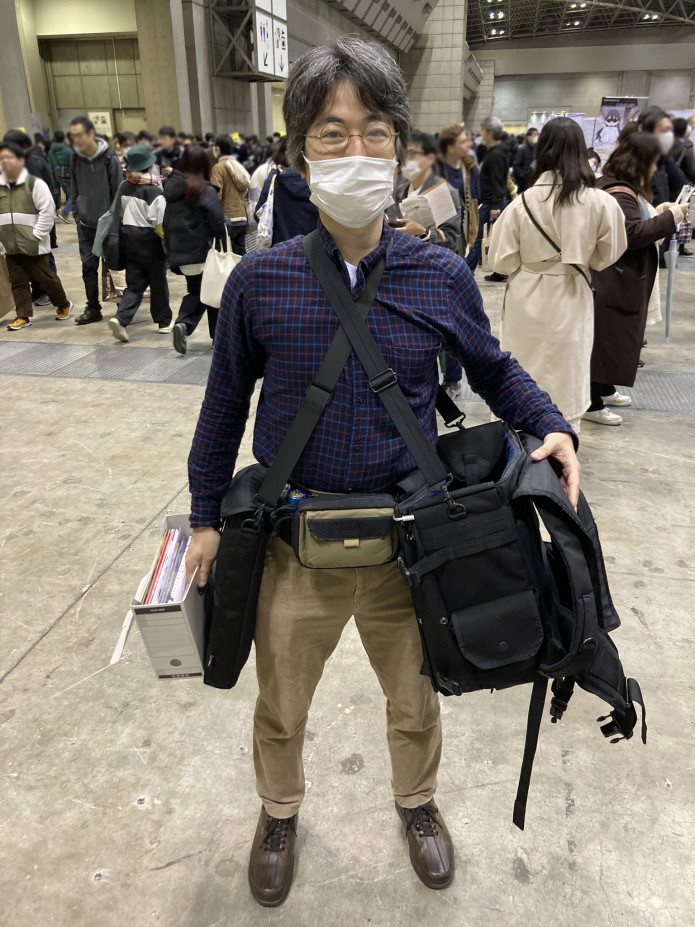
And this bag was crowdfunded on Japan’s crowdfunding site “Makuake” in 2023, and reached 1800% of its goal.
At the Comic Market in winter 2023, the product was actually used by people who bought it on Makuake and received high praise. We will explain later where it was particularly highly rated.
At that time, I made more with a view to selling them to the general public, so I took one to Sweden.
And my contacts in Sweden took a look at the bag and realized it was next to ideal to carry board games, due to its sturdiness and expandability. So we took it to a board game store and behold; the gargantuan Frosthaven slipped in as if they were made for each other.
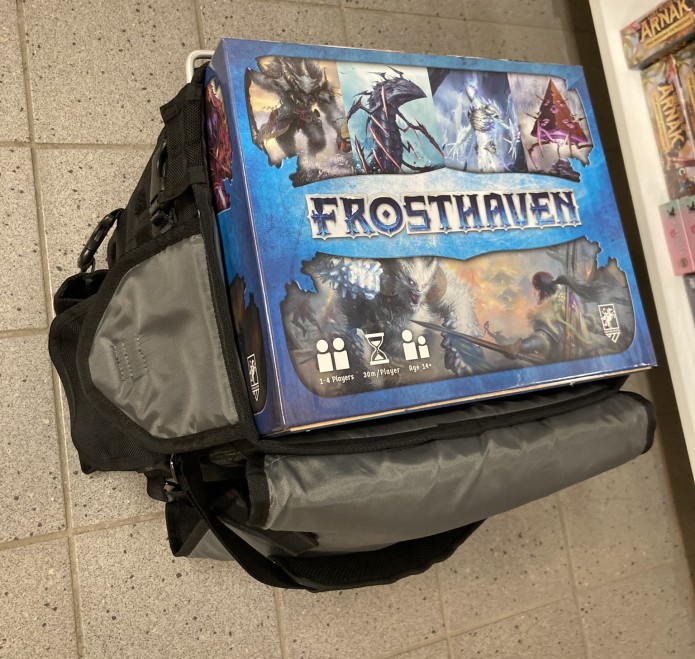
If Frosthaven fits, then so does most games. This bag is designed to hold a heavy load, and has a few tricks that work well for board games.
Here, for the first time in the world, a bag that is useful for comic markets, board games, and everyday use (especially for business) was born.
So we decided to try out a Indiegogo for those of you who look for a decently sized bag for your favourite hobby. A perfect bag for a gaming night, or for Gencon/Essen or any place where you expect to walk around with your purchases!
SPECIFICS
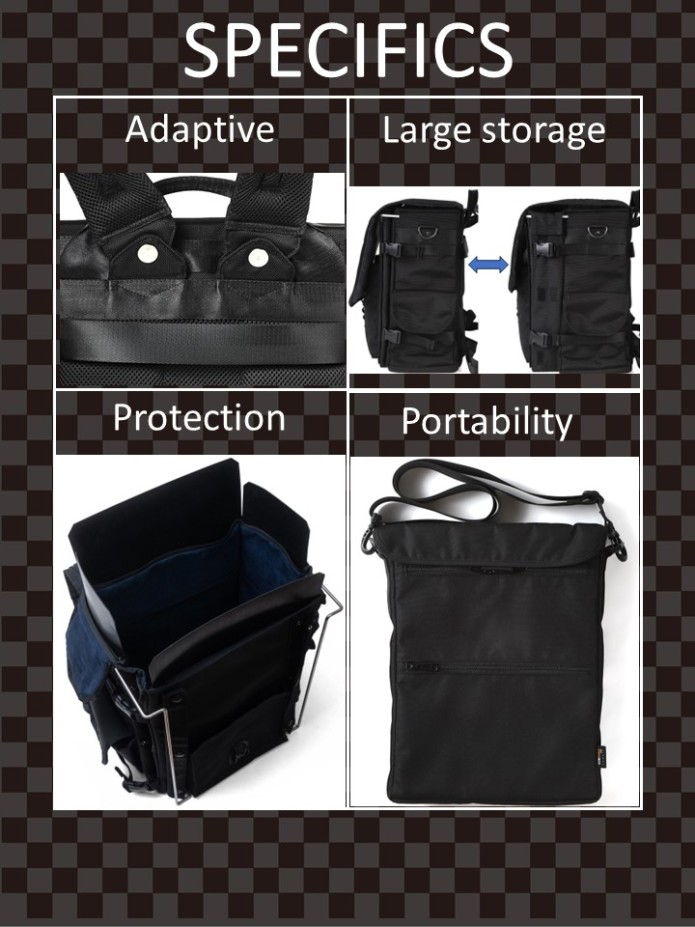
1 Adaptive
People come in all sizes, and so do those who visit Comic Market and who play board games. For this purpose, the shoulder belts connect to the bag on rotatable clips, to adapt for varying shoulder width.

The construction consists of a couple of plastic tiles called POM, 2 on the bag and 1 in the shoulder belt, fastened with a metal clip for sturdiness. This construction proved so useful that it can be used in several bag constructions. It’s patented in Japan (no 7316013).
https://www.j-platpat.inpit.go.jp/c1801/PU/JP-7…
As shown belot, it rotates to fit any shoulder width.
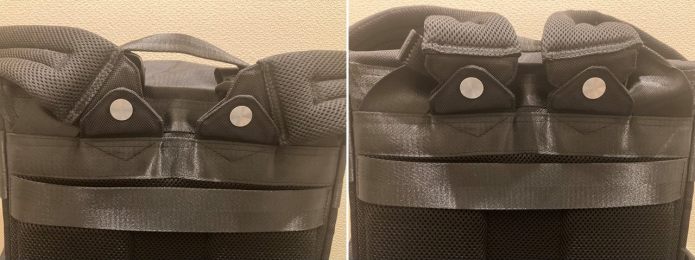
Sturdity tests showed that the metal clip snapped out at 400lbs (200kg). With the metal clip gone, the plastic tiles finally snapped at 780lbs (340 kg) weight.
Sturdity tests can be seen here:
2 Large storage
On Comics Market, roughly 12000 tables display their fanzines (dojinshis) each day. The limit to what one person reasonably can visit, is 200 tables. Most fanzines (dojinshis) are B5 (typical comic book), so the bag was designed so that the bottom could fit a flattened B5 book. However, a lot of people put these into plastic file case, which are typically A4 or slightly above, roughly 13″ x 8,5″ (32cm x 21cm). There you have the bottom size of the bag – slightly larger than A4.
The bag is roughly 16″ (40cm) high. A dojinshi is typically 1/10″ or 2,5mm, so you can fit in about 160 of these, stacked on top of each other. We considered making it fit 200, but that would make it 50cm high. This is too high to use on a daily basis as a business bag.
One prerequisite for the bag was to be accepted as hand luggage on domestic flights, (carry-ons are limited to 16″ x 10″ x 22″ or 40cm x 25cm x 55 cm) hence we opted for the slightly smaller option.
And thus, the bag originally tailor-made for massive Dojinshi shopping sprees turned out to be the size of a Frosthaven box.
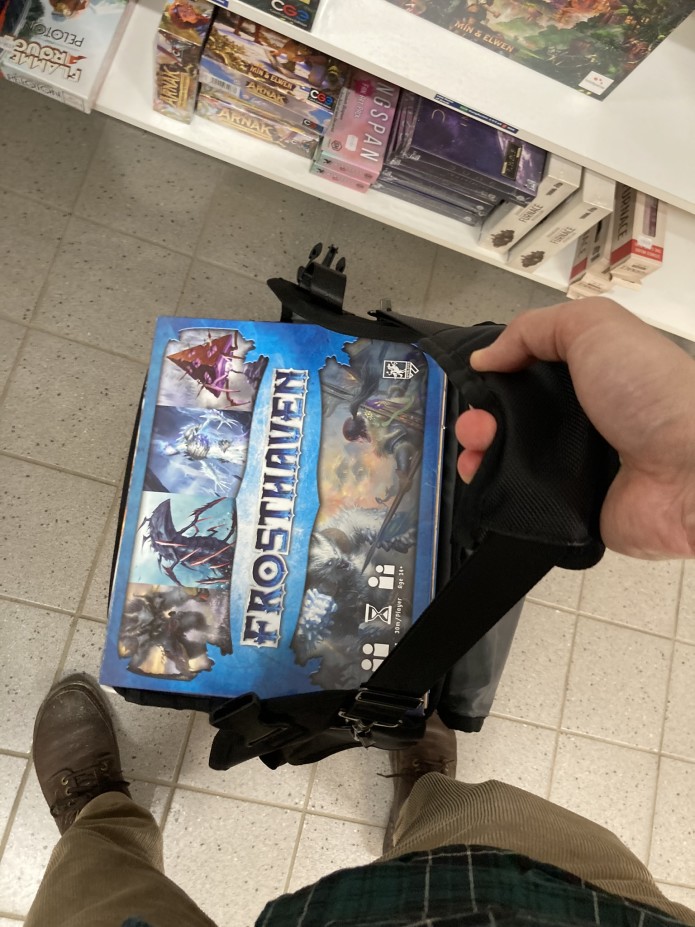
But as we all know, a backpack that fits something as large as Frosthaven will in fact be annoying when you’re just carrying around your regular stuff, and we wanted a bag that could be used on a daily basis. The solution? On normal days, it’s a regular size. But when you need it to, it grows.
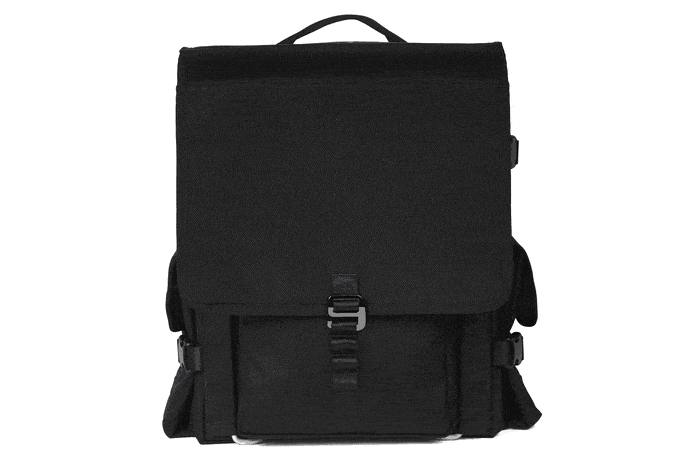
(As a note: When visiting board game fairs and going by plane, of course you’ll be putting most of your purchases in your check-in luggage, we know that. You won’t be able to fit in your entire Essen Spiel haul even in this fella. But you know, sometimes you want to keep those special games close. And how better spend the trip home than to check some of your finds?)
3 Protection
A bag isn’t a bag if it doesn’t protect what’s inside. And geeks do care about their stuff. We designed this to carefully protect dojinshis and not chip any corners. Some of this might be over-specced for boardgames, that aren’t as easily bent, but better safe than sorry.
First of all, the inside corners are not rounded, so as to not bend the corners of books and magazines.

Secondly, we designed it sturty enough to keep its shape despite being carried as a backpack, by inserting plastic walls.
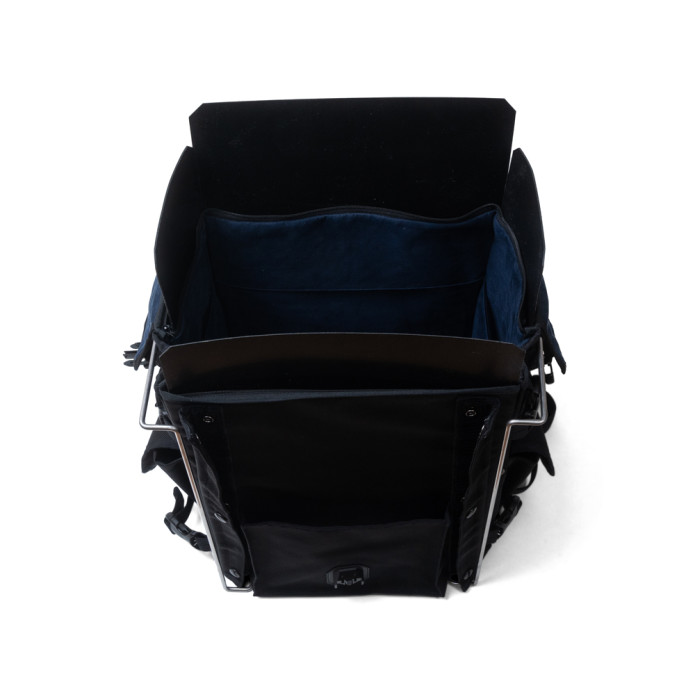
Thirdly, a metal frame to keep the shape upright.
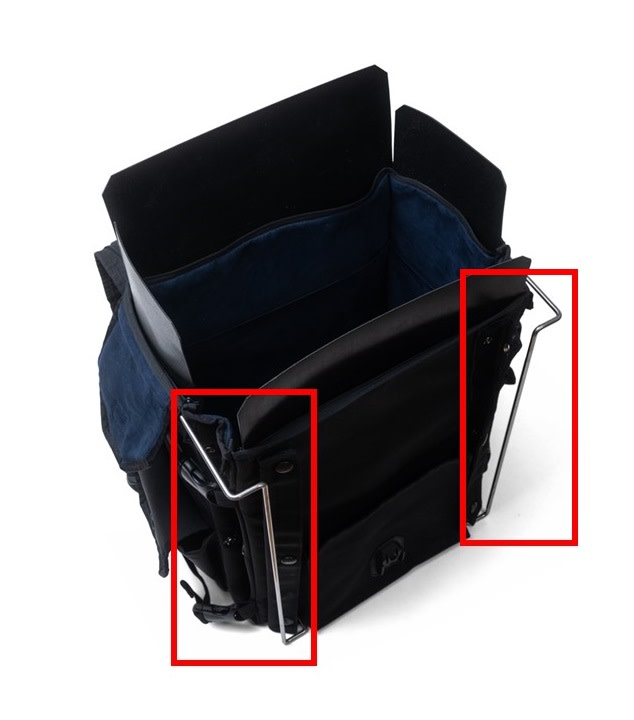
It’s a simple design, but it’s needed to send any potential side shocks into the plastic walls and the metal frame. This is particularly good in crowed market halls. This design to protect the corners of dojinshis is actually as good to protect your board game boxes from corner smashes.
The frame also serves the purpose of stopping the backpack from deforming when you lift it in the carry belt (see below)

The entire design has the purpose of keeping the “brick” shape regardless of how you carry the bag, and while expandable bags aren’t uncommon on the market, few of them share this construction and focus. This is as applicable for board games as it is for dojinshis.
This metal frame for bags is also patented in Japan (no 7316005)
https://www.j-platpat.inpit.go.jp/c1801/PU/JP-7…
4 Portability (separate shoulder bag)
For an everyday-use business bag, you can’t do without a case into which you slide a laptop or paper files. For this particular backpack, we opted for a separate shoulder bag instead of trying to cram it in the regular pack, for easy access.
This shoulder back has one larger pocket of 7″ x 12″ (18cm x 30xm) and two smaller of 5″ x 6″ (12cm x 14cm). Typically useful for smartphones, cables, power banks and pen cases.

The inner bag itself is 11″ x 15″ (28,5cm x 37cm ), and easily fits even larger laptops such as a 15.6″ Macbook Pro. Its sides are cushioned to protect a laptop, and, unless you’ve crammed Frosthaven into it, fits snugly into the main backpack if wanted. This shoulder bag holds the “business” part of the backpack set.
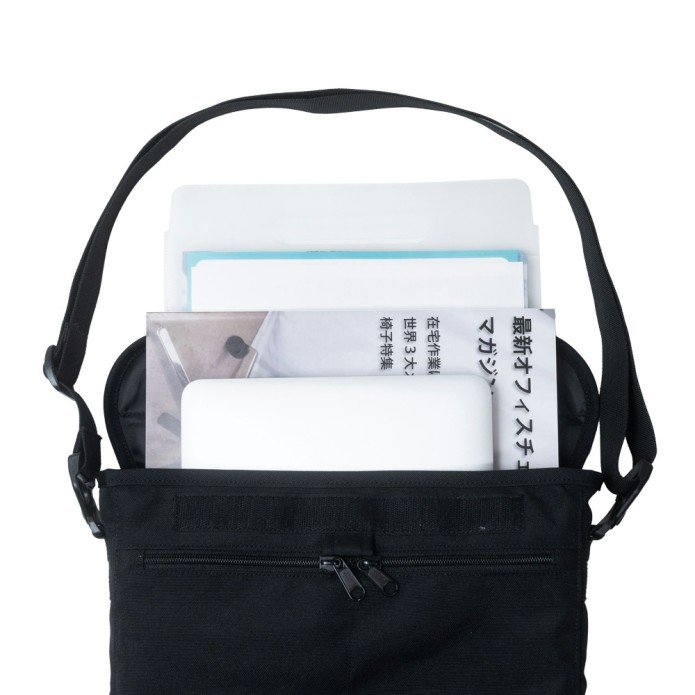
B5 slips in nicely, but as you can see, so does A4. In fact, they even go in sideways.
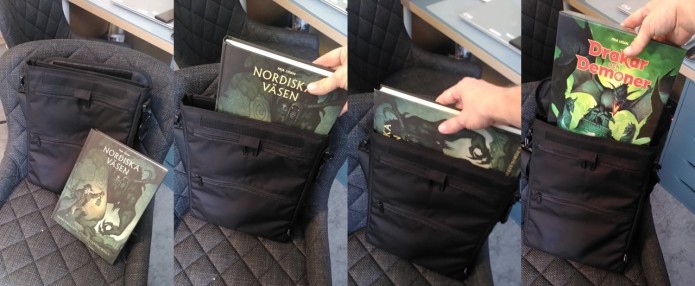
As much as 4 typical TTRPG core books and supplements fit nicely.

The shoulder bag is completely separate from the backpack. It’s constructed light and weighs only 200 grams. Together with the main backpack, it’s a powerful ally on Tokyo Game Market or Essen Spiel.
Other details
1 Rain protextion
The backpack is equipped with separte side-flaps to protect the contents against rain coming in from the sides. These come to full effect in the unexpanded state.
When the bag’s expanded, we needed a different solution for the expanded part.
So the flap that covers the top comes with two extra flaps to fold down over the metal frame. This way, even side-blowsn rain has a hard time coming inside.
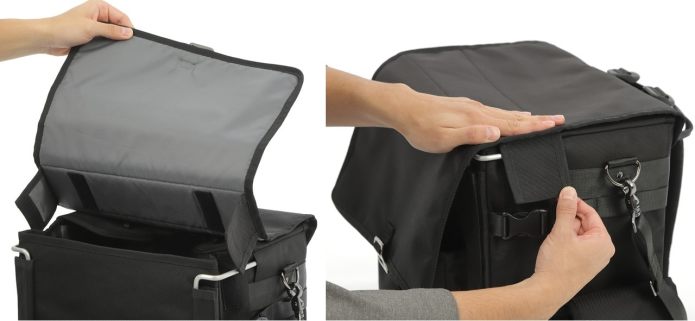
The material for the bag is 600D polyester, the typical fabric for outdoor gear, and even heavy-duty tents.
2 Load lift strap
The backpack comes with an extra “load lift” strap to keep the backpack tight to your back, which is specifically necessary when the contents are very heavy (such as Gloomhaven)

3 Expansion bottom sheet
The bottom sheet is a sturdy plastic sheet that fits the bottom when the bag is expanded.
This prevents the backpack from deforming if something is pressing from front.

By the way the upper part has two flaps that fold down over the metal frame, keeping the bag in its expanded state.

4 Extra pockets
Of course we need extra side pockets for various things. Our backpack is equipped with three large side pockets. The two on the sides are for drinking bottles, and the one on the frontside is for an A4 booklet or pamphlet, large enough to stick in some smaller card games.

5 Bottom Studs
I don’t like the bottom of my bag to get dirty.
So I wanted to reduce the surface area as much as possible, so I added bottom studs.

DESIGN AND PROTOTYPE
This backpack is not the first one I’ve designed. I designed bags for Comic Market use back in 2011, and another one in 2015.
The left one is the first, and the one to the right is the 2015 version.

The first backpack from 2011 was very good at first, but as my purchases at Comic Market increased, it grew too small, so I designed a new, larger one in 2015.
For this second one, I included all my previous experiences, and while it was a fantastic backpack for Comic Market, it was too big for everyday use. One of the best parts was a sewed-in bottom plate, that made it much sturdier than the first version, and you could easily stack B5-sized folders in it.


So, I used the first bag as an everyday pack, and the second version when I went to Comic Market and on travels. The first version got the most use, and eventually, it wore out. As the Covid panic hit the world, Comic Market was cancelled, and I had time over to re-think the design and figured that I’d want a bag that could be used both for everyday use, and for heavier use.
And that was the start of the design for this backpack. These were my personal requirements:
1. Expandable to fit B5 folders stacked flat
2. 4-way use: backpack, hand strap, shoulder strap, cart
3. Ability to withstand 30 kgs without deforming
At first, I focused on the sturdiness, and asked a few makers of “Randoseru”, the iconical Japanese schoolbag for elementary school children. It’s exceedingly sturdy, but I was told that the design couldn’t be changed.
I got so many “no”, that I wondered what could be the problem. I bought a second hand randoseru, dismantled it and experimented to see if I could make it expand. That is the photo to the left.

The box on the photo to the right is the experiment to use the back plate, the sides and the bottom of this randoseru, but with extra fabric glued on, before fitting the front plate.
I noticed then that, the expandable bit deformed, even if I used a rather sturdy fabric. Searching for some sort of metal construction that would support the expandable section, I figured that a bended metal frame might do the trick, and this was the result:
A simple aluminum bar bended into shape, though I did miscalculate the length on this first try. On the picture it’s slightly malformed, but this construction absorbed most shocks from the front and sides, and the bag didn’t deform even with heavier loads.
This became the basis for the metal frame, one of the distinctive metal parts from which the name “RAVEN YATA” is derived.
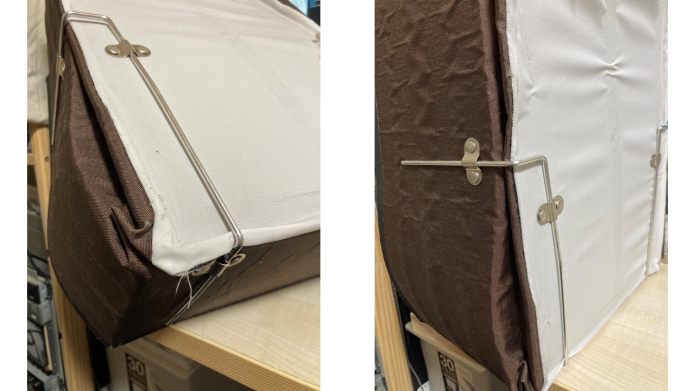
With this design, I contacted a few bag (nor randoseru) makers that could make bags on specific demand.
But I was told no again. The argument I was given was that it was impossible to get an expandability on a randoseru-based design, where the material is thick and hard to work with.
But I had my prototype, and I didn’t want to give up, so I figured that maybe makers of military bags could have some ideas, so I went to a maker of military equipment.
They ended up saying no aswell, but they told me that it would be possible to insert the sturdy core material after sewing, instead of using hard randoseru materials from the start.
From that information, I sewed together a a second prototype with just cloth.
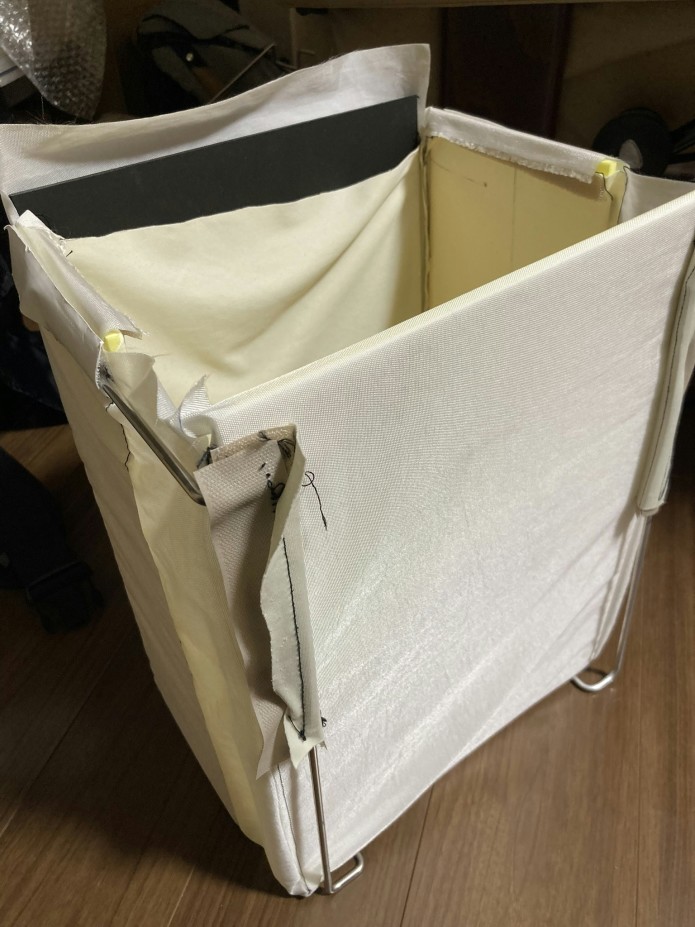
It’s an amateurish prototype, but with each side being a pocket in which you could insert some sturdy plates, I got a bag that did not deform when expanded.
When I made this prototype, I came up with another particularly specific part of this bag, namely the rotating back strap fasteners.

The 2015 backpack I designed was a good Comic Market backpack, but as you can see on the photo below, the place where the back straps are sewed on, is pulled sideways, and becomes a weak spot, and made the bag not fit tight on my back. Also, the angle of the pulling force would vary depending on shoulder width.

It wasn’t a part of my first requirements, but I figured that an important part was to get this slight defect fixed.
Many bags solve this by having cushioned back straps, or making them out of a mesh material, but these solutions only lightens the strain on the shoulders, and I wanted something that made the bag fit more snugly on the wearer’s back.
One solution hint was back to the randoseru design again: On such bags, there is a moving section where the back straps connect to the back plate:
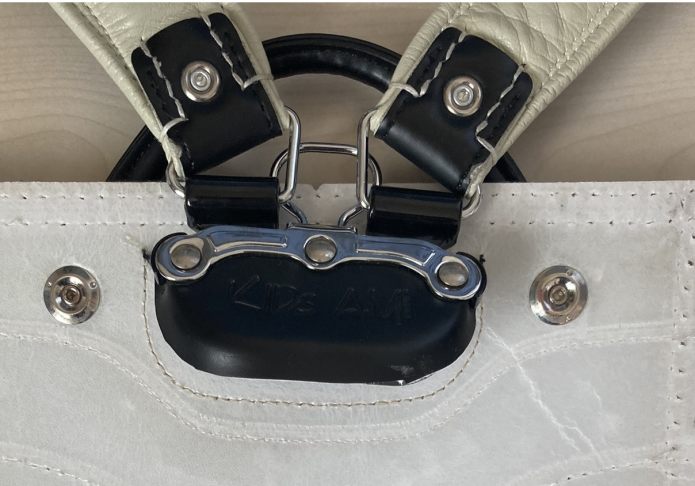
A randoseru is used in elementary schools, from the ages of 6 to 12. One bag is supposed to hold for all these six years, and kids grow tremendously during that time. A construction that fit a 6-year-old won’t be good for a 12-year-old and vice versa. The randoseru design was forced to accomodate for completely different body sizes.

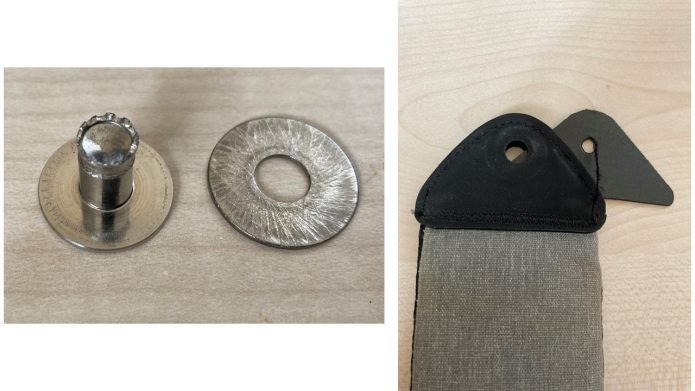
However, this construction was very specific, and also fully integrated with the back plate, which was impossible for my backpack.
But, another hint came from the Everyday Backpack from Peak Design, that had a rotating part for the shoulder strap, accomodating for various body sizes.
I got one, dismantled it, and it turned out to be a relatively simple design: a rivet on 1mm metal and plastic washers, fitted on larger plastic parts on the bag and shoulder straps.
But, just like the randoseru, these were an integral part of the back plate, and impossible to construct for regular “make your own design” bag makers.
Also, using plastic material made me worry if these would be able to withstand the relatively heavy load of a Comic Market shopping spree. I made my own attempt to implement this basic rivet-based rotating idea on a bag that could withstand heavy loads, and this was the first attempt:
The visible parts are based on Peak Design’s idea, but the construction is different: I fit the shoulder belt in between two sturdy plates, making it a module-based construction.
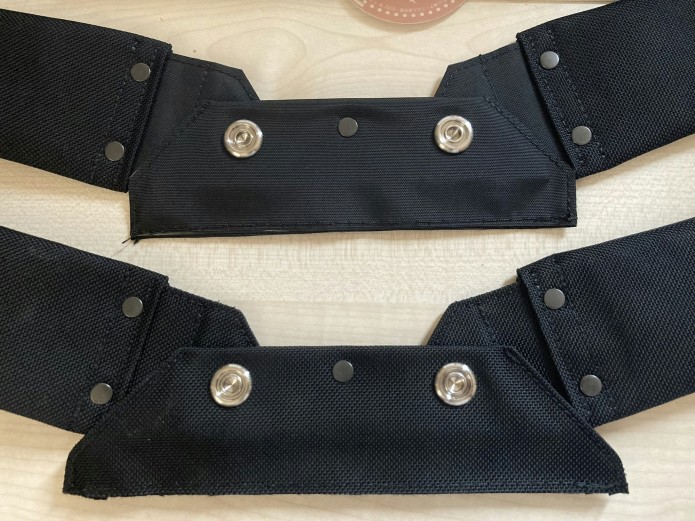
This would, I figured, be exactly what I was looking for.
I couldn’t use standard rivets, as they were too thin and weak. I needed 8mm thick, hollow rivets (like thick eyelets), just like Everyday Backpack used. Such hollow rivets were easily ordered from a parts maker.
More difficult than the rivets were the plastic parts.
As these would sit right on the wearer’s back, they needed to be able to withstand age and shocks without cracking. It wasn’t a case of “the harder, the better”, rather I needed something that
1. didn’t crack when bended
2. didn’t deform under pressure
Something that didn’t crack, but just whitened when bending was polyacetal, aka POM. I tried them, and as noted earlier, the prototype tests didn’t snap until 340kgs.
All this needed to be prepared and designed for beta. Luckily I managed to find Kawanishi Bag Production, based in Kagawa, Japan, a company who has made several niche bags. They were on board, I brought the second prototype I’d made, and after a couple of back-and-forths, they came up with this beta:

As I’d designed it after my liking, I am naturally biased, but this was exactly the backpack that I’d been looking for. It wasn’t just easy to use, but included the weird functions that I’d wanted.
As if it was made for it, it turned out it fit board games perfectly, and even took in Frosthaven, famous for being one of the biggest board games boxes on the market, so I decided to try a Indiegogo to see if I could reach a bigger audience that way.
Finally, as many have noted, the price tag.
300 dollars isn’t cheap for a back pack, I’m fully aware of that.
But there are several reasons for this high price.
The first reason is the is the small number. This is originally a niche bag designed with very specific prerequisites, and producing small number of these were the absolute limit for a company where I am the only one.
The second, and bigger reason, is the complicated design.
It’s brick-shaped, it’s expandable to a larger size, and constructed so that it holds shape even when expanded. This elevated the construction price significantly. The bottom plate, the hand strap, and several small details also elevated the price.
The third, and most significant reason was that the metal frame and the rotating back strap design couldn’t be made at the bag factory. These were tailor made at other factories. Without these two details, the bag would easily have been 100 dollars cheaper. But I didn’t want to do without them. They’re an integral part of the entire point of this backpack.
One fourth detail is the separate inner pack that was produced separately. I needed something for laptops to enforce the everyday use case for the entire set.
One detail that I did back on, was the fidlock I used for the prototype. It would add on another 20 dollars to the price per bag, so I opted for a regular fastener.
In the end, I figured that if I was to sell this bag to others, I couldn’t back out of the things that I wanted, that I had missed from other back packs. I needed to do exactly the bag I’d dreamt of.
So I included all I wanted. The result, the end product, isn’t a cheap one, but I’ve poured all my passion, my ideals and wishes into what I believe is an ultimate bag, not just for the specifically intended purpose, but for everyone who needs a sturdy, multi-use backpack.
Those of my backers who used the bag on winter Comics Market 2023 were all very happy with the functions.
So I am fairly proud of this design of mine, and am confident in that it delivers according to price.
If you believe that this might be the back pack for you, do try it out.
And thank you all for reading.
To wrap up with
Thank you for reading and considering.
You might have noticed that the target backing amount for success is very low. The explanation for this is easy: The bag is already manufactured, and all we need is a financial base to set up shipping to around the world.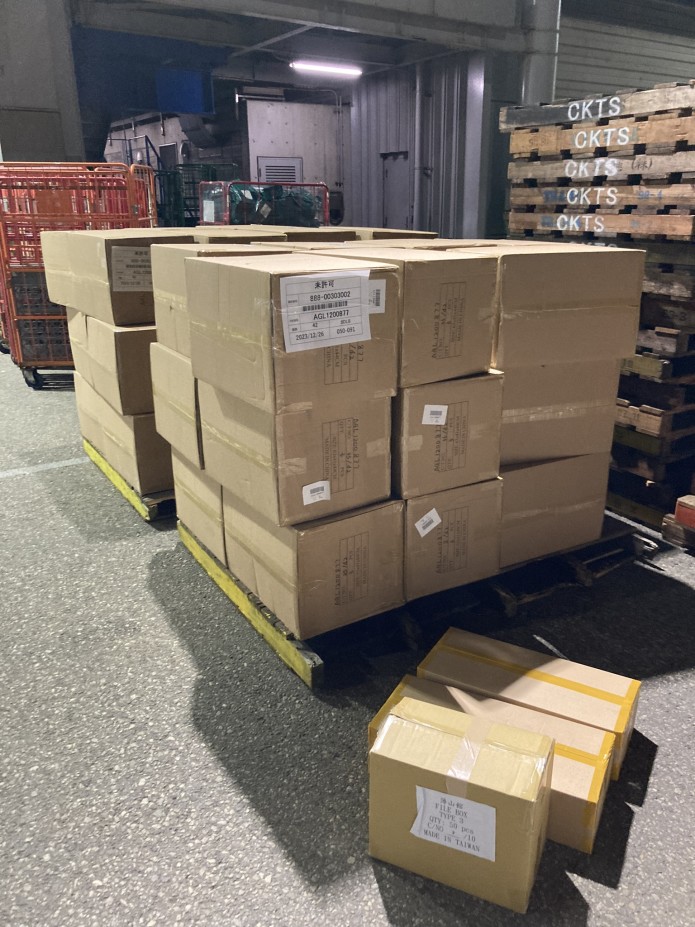
We’ve based this presentation on specifically board games, but as you have gathered, the bag is designed with pan-utility in mind, with a focus on keeping its brick shape constant and the contents protected from bumps. Thus, it’s equally suitable as a camping bag, carrying the heavier food stuffs, or generally when you’re shopping slightly heavier stuff.
Risks
As noted above, this bag has already succeeded its domestic crowdfunding in Japan.
We planned to sell this bag in Japan, but due to the Frosthaven fits, we decided to challenge the world through Indiegogo.
It’s already manufactured and ready to ship at a moment’s notice. Hence, there is zero risk for delays in production, the only “risks” involved in this project is if any trouble occurs during the shipping from Japan.
As the bag is sturdily designed, it cannot be compressed beyond the unexpanded state, which is why we have opted for the cheaper but slower sea freight as the default choice (the carbon footprint for sea freight is also considerably lower). Sea freight conditions have however, gotten slower in recent times, and the “two months” that once were the reality for sea shipping from Japan has turned into three or even four, at worst six months. (The possibility of freight delays due to trouble in the Suez canal, or force majeure, is of course also valid). This is about the only risk about this project.
For those who prefer the faster (but more costly!) air freight, we’ve added that as an option.
Comic Market” and “Comiket” are registered trademarks of Comiket Ltd. This project and products have nothing to do with Comiket Ltd. or the Comic Market Preparation Committee.
日本語版
ボードゲーム用鞄としての八咫烏
この「八咫鴉」は、昨年の2023年にクラウドファンディングサイト「Makuake」でコミケ等同人誌即売会で役立つ鞄として支援を募り、1800%を達成しました。
当初は、大量の同人誌を「守り」快適に「運ぶ」ことを目的に開発し、実際2023年の冬コミでMakuakeの支援者の方々に使って頂きました。そのうち何人かがX(旧Twitter)に報告を上げて頂いたところ、目的とした機能は十分に発揮したとのことで、同人誌即売会用の鞄としては面目躍如といったところでした。

そして、いつもお世話になっているスウェーデン人の翻訳家で大学のサークルの先輩であるシモン・ルンドストローム氏に今年の1月下旬に会いに行った際、記念にお土産として八咫鴉のセットを渡すとボードゲームが入るのではないかと指摘されました。時間も余裕があったためボードゲームショップを訪れ、Frosthavenというボードゲームを試しに入れてみたらすっぽり入りました。
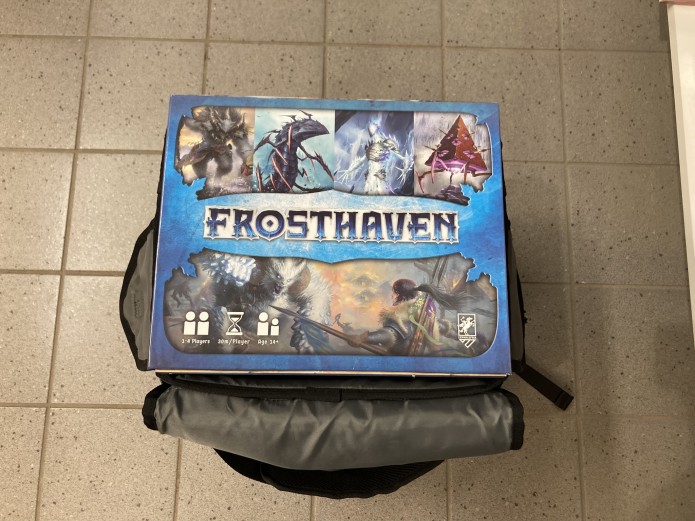
Frosthavenが入った時のシモン氏のテンションの上がりようは尋常ではなく、世界に向けて発表しないかと提案されました。
Makuakeの規約上、支援者に届けてから3ヶ月間はMakuakeで表示した価格以下に下げることができなかったのですが、キャンプファイアを始めとした、おかわりクラファンであれば大丈夫だったので、急遽一般販売を止めてIndiegogoに挑戦してみることとなりました。
尚、当初はKickstarterを考えていたものの、Makuakeと同様に世界で最初に商品を発表しなければならなかったため、この「八咫鴉」はMakuakeで成功したことから利用できませんでした。
八咫鴉の特徴・性能
①大容量と拡縮機能
Frosthavenが入るということは大抵のボードゲームが入るとのこと。そこでシモン氏に試してもらったところ、ボードゲームとしては大きめなサイズの「NEMESIS LOCKDOWN」と「NEMESIS AFTER EXPANSE」が2つ入りました。また上部の空間には「The EXPANSE BORAD GAME」が収まりました。
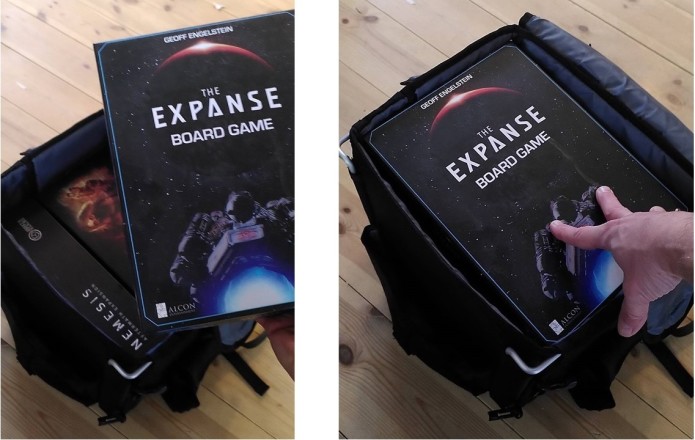
他にも複数のボードゲームを入れてみたところ、主気室には3~5個のボードゲームが入るとのことでした。

そして前面や側面のサイドポケットには小型のボードゲームが入れられました。

このように、同人誌用に作った鞄ですが、ボードゲームにおいても十分な収納・運搬能力を発揮することがわかりました。

尚、これらは拡張状態での写真となっておりますが、マチを8cm収縮することが出来るため、電車に乗る際などに支障を来さずに日常やビジネス用途で使うことができます。
通常時のサイズ: 16cm x 32cm x 40cm
拡張時のサイズ: 24cm x 32cm x 40cm
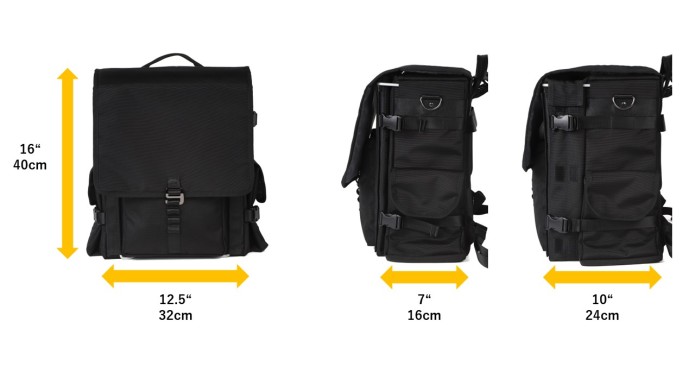
②直方体形状と特性金属フレーム
八咫鴉には内容物を傷つけないために「箱型形状」と「芯材と特性フレーム」という2つの工夫を凝らしました。
まずカバンの持つ丸みで角を痛めることを防ぐためには、ランドセルのような角張った箱型形状は必須だったため、底面含めて五面に芯材を入れ、箱型形状のカバンを実現しました。

更に日常使いも考慮すれば、Frosthavenが入る容量、特にB5サイズ同人誌が余裕で平積みできる奥行きは、日常生活には大きすぎるため、8cm収縮する機能を搭載しました。
そして単純な構造ながら立体的に4か所曲げて、拡張しても肩がけしたり、イベント会場で押されることでの型崩れを防ぐフレームを導入しました。これらにより、今まで以上にボードゲームを傷つけること無く運ぶことが出来るでしょう。


尚、このフレームは特許を取得しております。(特許7316013)
https://www.j-platpat.inpit.go.jp/c1801/PU/JP-7…
③旋回接続金具
イベント会場では基本肩がけとなりますが、やはり背負心地は大事です。特にイベントでは幅広い体型の方々が参加されるため幅広い体型の肩幅にフィットする背負いベルトは必要不可欠です。
そこで考えだしたのが、旋回接続金具です。

構造としてはフレーム同様シンプルで、本体気室に取り付ける2枚のプラスチックの板と背負ベルトの付け根に入れたプラスチックの板を中空リベットでかしめています。
見た目の通り、背負ベルトが回転し、幅広い体型の肩幅にフィットします。

性能面としては、背負いベルトが肩幅に合わせて回転するため、少なくとも使っている私自身の肩幅にはフィットし非常に快適です。
また機能性のみならず、金属部品の中空リベットがアクセントとなっている点も気に入っています。
尚、強度としては340kgfで壊れたため、イベントでの使用では問題ないでしょう。
こちらも特許を取得しております。(特許7316013)
https://www.j-platpat.inpit.go.jp/c1801/PU/JP-7…
④携帯性・ビジネス的要素
ビジネスでも使えると銘打っていますが、八咫鴉にはノートPCや小物を入れられるポケットや空間はありません。
そこで八咫鴉のビジネス的側面を補うべく、ノートPCなどが入れられるインナーバッグを作りました。18cm x 30xmの大型ポケットが1つと12cm x 14cmの小型のポケットが2つ。ペン挿しも付いています。

詳細なサイズは28,5cm x 37cmと、15.6インチの大型のノートPCも運べるサイズとなっています。

そして、ボードゲーム周りのカバンとしては、このサイズ感がゲームブックを入れるのにも役立つとシモン氏から指摘して頂き、実際に入れてみたのが下の画像になります。

スウェーデン製のゲームブックとのことですが、A4サイズは普通に入りますし、B5サイズであれば、小規模即売会で使うことも前提にしているため横にして入れられます。
容量としては本の厚さによりますが4~5冊は入るとのこと。

その他特徴
①雨対策
カバンを拡張した際、拡張部から雨が入り込む可能性があります。
そこでフラップに下の画像のような雨除けを取り付けることで拡張時でも雨が入りづらい工夫をこらしました。

②ロードリフトストラップ
旋回接続金具に加え、八咫鴉ではロードリフトストラップを導入することで、背負い心地をより向上する工夫を加えました。
ロードリフトストラップを引っ張ることで、よりカバンが背中に接着するため、重い荷物を入れた際の負荷が減るでしょう。

③拡張時用下敷き
カバンを拡張した際、底面に力が加わっても変形しないよう、追加の下敷きを用意いたしました。

④底鋲
試作には無かったのですが、量産版で取り付けたのがこの底鋲です。
個人的な意見なのですが、鞄をそのまま床に置くことに抵抗があるので、出来るだけ接地面積を減らすために用意しました。

購入するに際して登録は手間ではありますが、Makuakeより手数料が安かったため、価格に反映し送料含めてもMakuakeより安く購入することが出来ますので、ご興味ありましたら是非ともお手にとっていただけたら幸いです。
・「コミックマーケット」「コミケ」は、有限会社コミケットの登録商標です。本企画・商品は、有限会社コミケット、コミックマーケット準備会とは関係はございません。

